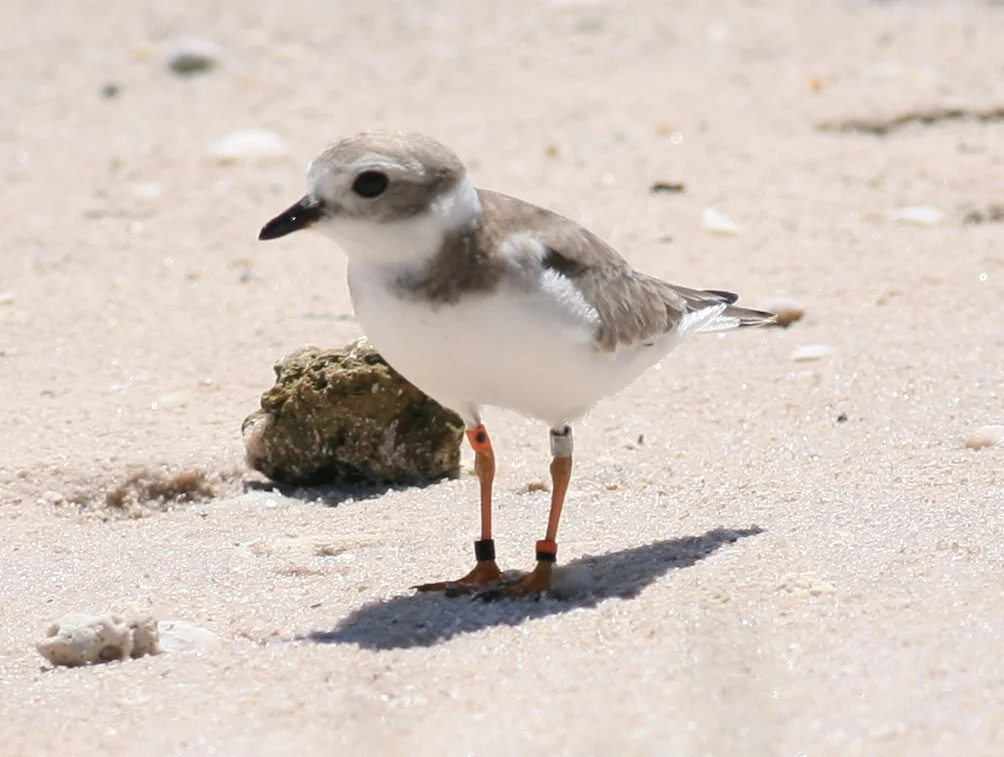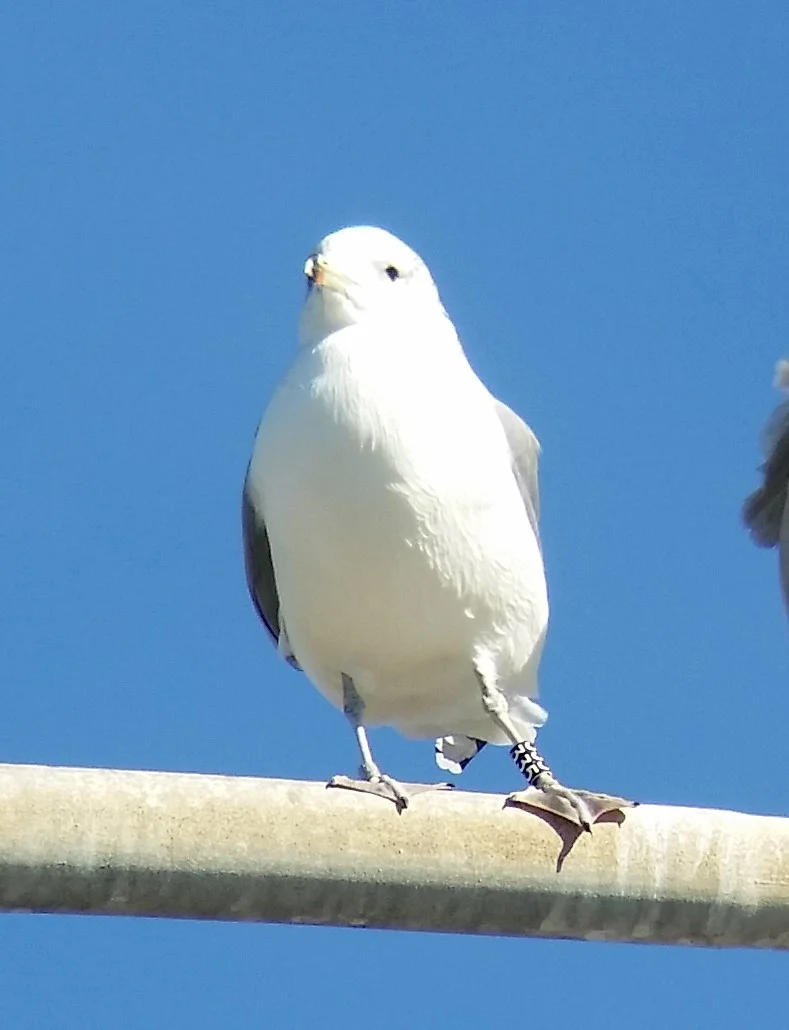Bird banding is critical to understanding bird biology and behavior. The banding of birds allows biologists to better understand birds’ use of habitats, where they forage for food, where they nest, and when and where they migrate, or if they migrate at all. With this detailed knowledge of land use, biologists and government agencies can manage habitats that are critical to the survival of many species of birds.
Bird banding is one of the only ways biologists can identify individual birds of the same species. These unique bands are used for population estimates, dispersal ranges, and migration routes, just to name a few valuable recourses gained by banding birds. The Swainson’s Hawk (Buteo swainsoni) in Photo 1 below was just a Swainson’s Hawk in a population of Swainson’s Hawks until it was captured and had two bands put on its legs.
Photo 1: A banded adult Swainson’s Hawk in the Antelope Valley, Los Angeles-Kern County, California by Pete Bloom (Kerry Ross ©).
In this case, the band on the right leg is a federal band provided by US Fish and Wildlife Service and the other band on the left leg is a color band (also known as an alphanumeric band) which allows biologists and the public to identify that specific individual at a distance. The federal band (made of aluminum or similar materials) has a number around it that is unique to that bird. The problem with these bands is that they are extremely difficult to read even with the best optical equipment and lots of time. The difficulty of reading a federal band can be seen in nearly all of the photographs shown here. They are practically unreadable in the field. The solution is to have another band that is easier to read from a distance, like the adult Swainson’s Hawk in Photo 1 and the juvenile Swainson’s Hawk in Photo 2. This second color band can have a wide range of colors, numbers, and/or symbols to make a unique identifying sequence for each bird. These color bands allow biologists to identify a specific bird and know more about its specific life history.
Photo 2: A juvenile Swainson’s Hawk that was banded in the nest in Kern County, CA by Pete Bloom (Kerry Ross ©).
Looking at the Swainson’s Hawks in Photos 1 and 2 we can see that we cannot read the federal band (right leg) on either bird. In the case of Photo 1 the color band numbers read “40” with a stripe on top, and in Photo 2 the color band reads “28”. When reading these bands it is very important to take note of the color of the band as well as the color of the numbers or letters. In both of these photos the colors are white on black. This means that the band color is black and the numerical color is white. As there are many different variations possible, recording this correctly is important. With this knowledge a biologist can track movements of a bird both seasonally and annually.
In order to maximize the number of unique color bands available for biologists these color bands use a wide range of colors and code arrangements to allow for many birds of the same species to be uniquely banded. The band can be one of many different colors while the numbers, letters and symbols can also be selected from a few different colors. The main limitation for unique combinations is choosing colors that stand out or contrast well with each other, making them highly visible.
Another way to uniquely band birds is to use multiple color bands on each bird. This is most widely used in shorebird studies. There are many species of shorebirds that are being studied across the globe and many of them can be found in easily accessible locations. A good example of this in the eastern United States is the Piping Plover (Charadrius melodus) seen in Photo 3. Biologists have had to come up with as many new band combinations as they can in order to band as many Piping Plovers with unique bands as possible. In this case you can see that two bands are above the knee (anatomically the wrist) on both legs and two are below in the ‘normal’ position above the foot. This differing band placement is another way to maximize the potential number of band combinations for a given species.
Photo 3: This Piping Plover from The Florida Keys Hawkwatch in Miami-Dade County (FL) has a very unique band configuration. These bands have multiple colors and symbols as well as a different location on the leg (Kerry Ross ©).
If you look close at the top orange band on the birds right leg you can see a black spot on the band and then when you look and the bottom band on the birds left leg it is two colors on one band, orange over black. In the case of many shorebird studies, color combinations alone are not enough, even though it may seem like there are a lot of possibilities. When colors and numbers are limited, banders resort to symbols to help add band combination availability. This was used with the Piping Plover in Photo 3, and also can be seen on the band on the Black Brant (Branta bernicla nigricans) in Photo 4. The Black Brant has a white-on-black heart symbol, which comes before the number 74.
Photo 4: This Black Brant has a color band on the right leg with a number and the unique shape of a heart. The bird was banded in Bethel Alaska in July of 2007 and observed again on December 9 2016 in Mission Bay, San Diego CA (Kerry Ross ©).
Notice that the Black Brant does also have a silver federal band, but again, it is unreadable in the field. Wild birds can only be color banded by a person with a federal bird banding permit, so there should always be a federal band on a bird with a color band.
Another way to individually mark birds is with a patagial wing tag. These are used for birds that spend a lot of time flying and or swimming on water where their legs are difficult to see. The American White Pelican (Pelecanus erythrorhynchos) in Photo 5 is a perfect example of that. If this bird had a colored leg band you probably wouldn’t see it because it’s wading in the water. Even the large federal band can’t be seen below the surface of the water. The patagial tag allows an observer to collect the unique identifier on the tag (color and code - essentially the bird’s name), and report it to the scientific community, who in turn will use that observation to better understand the movement and life history of the birds being studied.
Photo 5: An American White Pelican with a patagial wing tag on its right wing. This bird was banded on July 18 2012 in Minidoka County, Idaho and seen again August 9 2015 in Piute Ponds, Los Angeles County, CA (Kerry Ross ©).
Photo 6: A California Condor with a patagial wing tag on its right wing, Kern County CA (Kerry Ross ©).
The real value of bird banding comes from these re-sighted bird bands and tags. The information that can be gathered from a re-sighted band include longevity of a species, behavior, migration routes, home ranges, to name a few. All of these broad categories are vitally important to understanding the required needs of birds. A greater understanding of birds’ needs can allow policy makers to better implement conservation efforts and to minimize population declines.
Photo 7: This California Gull (Larus californicus) has a white on black leg band on its left leg. It was banded in the nest near Lee Vining California, and was seen and recorded again near Fiesta Shores, San Diego County CA (Kerry Ross ©).
If you ever see or find a banded bird please take some time and try to record whatever information you can, then report it to the Bird Banding Lab at The United States Geological Survey web site (www.reportband.gov). It’s an easy process, and you will receive a certificate of appreciation from the Lab, which will have details about where the bird was banded and its approximate age. And, the researcher who banded the bird will receive an official notification of your sighting - the data you submit can make a real difference for the understanding of bird biology.
Written By: Kerry Ross






